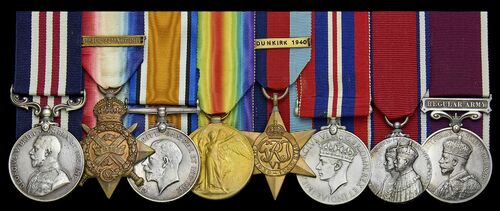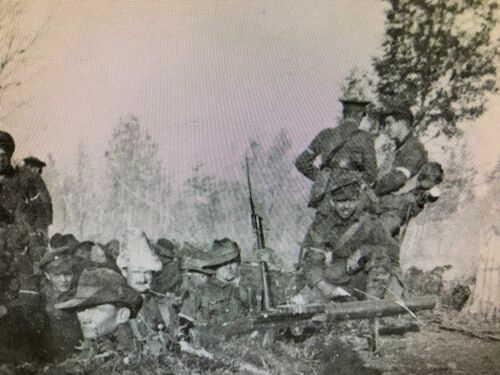Auction: 24001 - Orders, Decorations and Medals
Lot: 194
(x) A North Russia M.M. group of eight to Lieutenant (Quartermaster) H. Hardisty, Duke of Wellington's Regiment, late Royal Fusiliers and West Yorkshire Regiment
Military Medal, G.V.R. (129908 C. S. Mjr H. Hardisty. 45/R.Fus:); 1914 Star with clasp (9581 L.Cpl H. Hardisty. 2/W. York:R.); British War and Victory Medals (9581 W.O.CL.2. H. Hardisty. W.York.R.); 1939-1945 Star, with a privately made 'Dunkirk 1940' clasp; War Medal 1939-45 (QM.Lt. H. Hardisty. D.W.R.; Jubilee 1935; Army L.S. & G.C., G.V.R. (4603102 W.O.CL.II. H. Hardisty. D.W.R.) very fine overall (8)
M.M. London Gazette 22 January 1920.
Henry Hardisty was born on 28 April 1891 and joined the West Yorkshire Regiment at York in 1911. He saw service in Malta and later Albania before the Great War and on the outbreak of war saw service overseas in France from the 5 November 1914 (1914 Star & clasp), his Medals being issued in 1938. He returned Home in April 1915 and was attached to the West Riding Regiment for six months before returning to France with the West Yorkshire Regiment.
He remained in France for the remainder of the war, being slightly wounded twice. He was transferred to the Royal Fusiliers and was sent to North Russia in 1919.
45th Royal Fusiliers in North Russia
The British North Russian Relief Force was formed primarily of 45th and 46th Battalions, Royal Fusiliers, who arrived in Archangel to form a rear guard for the Contingent's retreat. The volunteer brigade of the relief Force was commanded by Brigadier-General LW de V. Sadlier-Jackson, and arrived in Russia on 5th June 1919. There was additionally a number of Australian troops who were prominent in several actions, their first of major importance being on 23rd July. On this occasion, 150 of them had gone with General Ironside when he went to investigate a meeting of White Russian forces at Obozerskaya. It was this group who repulsed a Bolshevik attack on a railway in the area. The Australians surprised the enemy during a relief of their forward blockhouses, killed thirty with the bayonet, wounded many others and set fire to the blockhouses before withdrawing.
Brigadier-General Sadlier-Jackson launched an attack with his brigade, including the Australians, on the Dwina front on 10th August and this also was a complete success. Over 3,000 prisoners were taken and heavy losses inflicted. The objective of enveloping and destroying the enemy was attained, thus opening the way for the peaceful evacuation of British and Allied forces. Nineteen days later, the two Australian companies were again employed in routing the Bolsheviks in a bayonet charge on the railway near Seleskoe. By this time General Lord Rawlinson had arrived in the country to direct the evacuation of all Allied forces and, on 10th September, the withdrawal to Archangel commenced. This operation was completed by the 23rd, and the troops embarked for home five days later.
In 1920 Sgt.-Major Hardisty joined the 2nd Battalion, The Duke of Wellington's Regiment at Sheffield, and went to Ireland with the Battalion. In 1922 he accompanied the Battalion to Egypt and later to Singapore, returning to England on Boxing Day, 1928. He was drafted to the 1st Battalion at Devonport after furlough, and within a fortnight of joining the Battalion was appointed to the permanent staff of the Territorial Army. He joined the 6th Battalion in February, 1929, and served for two and a half years at Keighley as C.S.M., coming to Skipton in September, 1931, and retired in January 1935.
In his private life he was up before the Leeds West Riding Court on 25 February 1919 being accused of desertion and living with someone else in Whitley Bay when the matrimonial home was at Thorner. He had written to his wife claiming his love had died, and asked whether his wife wanted him to return home she refused.
Subject to 5% tax on Hammer Price in addition to 20% VAT on Buyer’s Premium.
Sold for
£1,400
Starting price
£900







